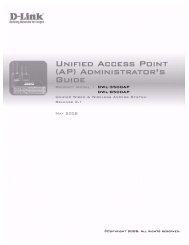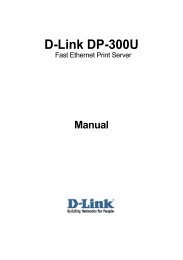Product Manual
Product Manual
Product Manual
Create successful ePaper yourself
Turn your PDF publications into a flip-book with our unique Google optimized e-Paper software.
DES-3526 / DES-3526DC Fast Ethernet Layer 2 Switch<br />
and a BPDU has still not been received from the Root Bridge, the Switch<br />
will start sending its own BPDU to all other switches for permission to<br />
become the Root Bridge. If it turns out that your switch has the lowest<br />
Bridge Identifier, it will become the Root Bridge. The user may choose a<br />
time between 6 and 40 seconds. The default value is 20.<br />
Forward Delay (4 - 30 sec) The Forward Delay can be from 4 to 30 seconds. Any port on the Switch<br />
spends this time in the listening state while moving from the blocking state<br />
to the forwarding state.<br />
Max Hops (1-20) <br />
Used to set the number of hops between devices in a spanning tree region<br />
before the BPDU (bridge protocol data unit) packet sent by the Switch will<br />
be discarded. Each switch on the hop count will reduce the hop count by<br />
one until the value reaches zero. The Switch will then discard the BDPU<br />
packet and the information held for the port will age out. The user may set<br />
a hop count from 1 to 20. The default is 20.<br />
TX Hold Count (1-10) Used to set the maximum number of Hello packets transmitted per<br />
interval. The count can be specified from 1 to 10. The default is 3.<br />
Forwarding BPDU This field can be Enabled or Disabled. When Enabled, it allows the<br />
forwarding of STP BPDU packets from other network devices. The default<br />
is Enabled.<br />
Configuration Name<br />
Enter an alphanumeric string of up to 32 characters to uniquely identify the<br />
MSTP region on the Switch. This Configuration Name, along with the<br />
Revision Level value will identify the MSTP region configured on the<br />
Switch. If no name is entered, the default name will be the MAC address of<br />
the device. This field is only valid when MSTP is the version of STP globally<br />
set on the Switch.<br />
Revision Level (0-65535) Enter a number between 0 and 65535 to identify the MSTP region. This<br />
value, along with the name will identify the MSTP region configured on the<br />
Switch. The default setting is 0. This field is only valid when MSTP is the<br />
version of STP globally set on the Switch.<br />
Click Apply to implement changes made.<br />
MST Configuration Table<br />
The following screens in the MST Configuration Table window allow the user to configure a MSTI<br />
instance on the Switch. These settings will uniquely identify a multiple spanning tree instance set on<br />
the Switch. The Switch initially possesses one CIST or Common Internal Spanning Tree of which the<br />
user may modify the parameters for but cannot change the MSTI ID for, and cannot be deleted. To<br />
view the Current MST Configuration Identification window, click Configuration > Spanning<br />
Tree > MST Configuration Table:<br />
Figure 6- 21. Current MST Configuration Identification window<br />
The window above contains the following information:<br />
49

















